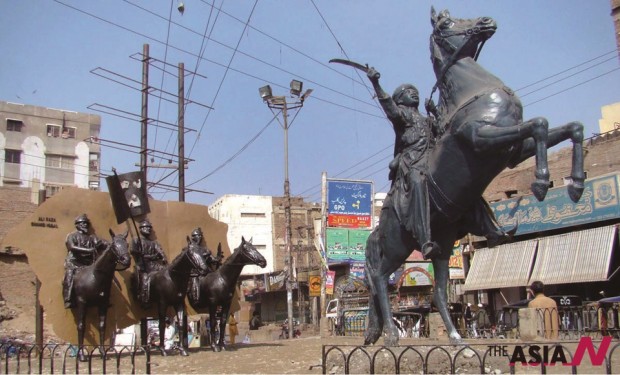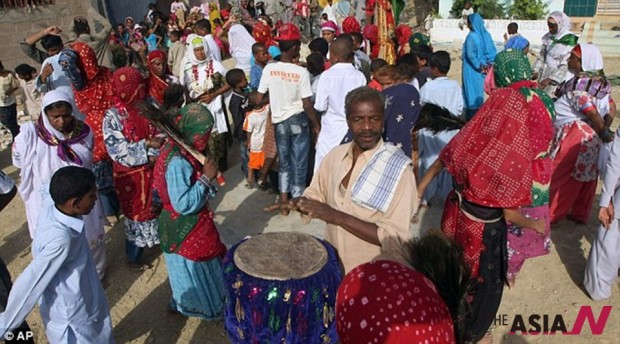African presence in Sindh
Prof. Adams B. Bodomo, hailing from Ghana, who headed the Department of African Studies at University of Hong Kong and University of Vienna, Austria, and also a visiting professor at Ansted University, Malaysia, rightly said over a decade ago during a lecture that despite not-so-tenuous historical, cultural and linguistic connections between Africa and Asia, Africa is not very present in the minds of Asians compared to other parts of the world. The theme of his paper was “African presence in Asia,” in which he discussed the historical links between Asia and Africa by tracing the history of the African population settled in Asian countries like India, Pakistan, Sri Lanka, Maldives and also China. Inspired by his theme, I chose “African presence in Sindh” as the title of my article because Sindh as well as Balochistan, the provinces of Pakistan, are home to hundreds of thousands of people with African ancestry.
Very poor, belonging to the working class, mostly illiterate, living in slums in seclusion, deprived of basic amenities, not content with their living conditions, yet they look happy as they start dancing whenever and wherever they listen to music and drumbeating, making it their cultural identity. They are known as Sheedis and Makranis. These people are so famous for their passion for dancing that when a non-Sheedi or non-Makrani dances in such a way, he is said to be under the influence of Sheedi Spirit.
The Sheedis and Makranis are the descendents of East Africans-men, women and children enslaved and shipped to different continents including Asia centuries back, first by Arab traders and later by Portuguese and British colonizers, where they were sold to work as farm workers, port workers, horse-keepers, palanquin carriers, and apprentices to blacksmiths and carpenters, domestic servants and also as soldiers for their physical strength and hard work.
Sir Richard Burton, who served in the British army in Sindh wrote in 1851 in his book Sindh, and the Races that Inhabit the Valley of the Indus that 700 slaves from Mombasa, Zanjibar and other African regions were imported to Balochistan annually. Females were in great demand and priced at 50 pounds. Children were bartered for grain, cloth and other goods. Some other historians said that in 1650 AD, Oman traded more heavily and transported Africans to the Makran Coast of Balochistan. From Makran the African slaves were sold to Sindh, the neighboring state. It is said that the Talpur rulers of Sindh used to buy hundreds of African slaves annually.
The African slaves were also known for their loyalty. Although brought here as slaves, they served the masters well and earned their trust. The Africans won the hearts of the local people too for their friendly behavior and with the passage of time became an integral part of Sindhi society and considered themselves Sindhi (natives of Sindh) and Sindh as their motherland. This is evident from the fact that many Sindhi soldiers of African origin laid down their lives while defending Sindh during war with invading British forces in 1843.
The commander of the Sindhi army Hosh Muhammad Sheedi was one of the African descendents who was martyred in a battle with British forces in 1843. The battle was fought near Hyderabad, the then capital of Sindh, 160km northeast of port city Karachi.

A view of replica of Sindhi legend Hosh Muhammad Sheedi who was martyred in a battle with British forces in 1843
Hero of Sindh, General Sheedi
Since then, General Hosh Muhammad Sheedi has been considered a hero by the people of Sindh, as his last words while fighting the British forces were: Marvesoon, Mervesoon, Sindh na desoon (We will lay down our lives, but will not let you conquer Sindh). His words became the national slogan of Sindhi people who still are fighting for their rights although British rulers left the Indian subcontinent after a 103-year long rule in 1947. The Sindhi writers and intellectuals often quote the African-origin soldier in their articles and books and refer to him as “Hoshu Sheedi” showing love and respect for their hero. The textbooks in primary schools also contain lessons on Hoshu.
Pakistan has the highest number of African descendents in South Asia, as they are settled in Balochistan and Sindh. At least a quarter of the total population of the Makran Coast in Balochistan are of African ancestry and are called Makrani. As internal migration took place, a large number of these people settled in Karachi, where they concentrated in the downtown area of Lyari, Manghopir and other outskirts of the capital city of Sindh.
A street in the Lyari area of Karachi is named “Mumbasa Street” while a village of Karachi is known as “Sheedi Village.” Those who served Talpur rulers inhabited Hyderabad and other districts in the lower region of Sindh. With the passage of time, they also started to intermarry with other communities. In Karachi, intermarriages with the Baloch community are common.
In Karachi, they hold a three-day annual festival at Manghopir, a shrine of a saint famous for crocodiles living in a nearby pond. Similar festivals are held at different places. Thousands of Sheedi community people including women and children actively participate in festivals and sing songs and dance. Their famous song is “Sheedi Basha, Hum Basha.” The Makranis and Sheedis are Muslim by religion and speak Balochi and Sindhi languages. The total population of Makranis and Sheedis in Karachi and other parts of Sindh is estimated to be over one million.
The Afro-Sindhi community, as it could be identified now, are no longer slaves. They are free and citizens of Pakistan, having equal rights as others under the Constitution, but in reality the situation is contrary. Since they belong to the working class, they can not focus on education. Their children are among those who dropout after primary or secondary school due to poverty and start working to earn a livelihood. A very few people are seen in government jobs as well as in the corporate sector. None of them could rise to higher positions in any sector after the inception of Pakistan in 1947.
The Afro-Sindhi community, however produced extraordinary figures in the field of sports, especially in hockey and football. In the early years of this newborn country, sportsmen of this community earned honor for Pakistan at the international level by playing in the Olympic Games. But, unfortunately they were not supported by any of the successive governments or other bodies and thus, lived miserable lives. Despite such behavior, the Afro-Sindhi youth continue playing hockey and football, forming their own teams at the local level.
Owing to such a situation, a deep sense of deprivation prevails among Balochi and Sindhi-speaking Afro-Sindhi communities. “Our ancestors used to work hard as slaves during the Talpur rule and British colonial era, but even the independence couldn’t bring any change in our life,” Akbar Baloch, the first-ever photojournalist from this community, told Magazine N.
70-plus Akbar, who graduated from university, started as a part-time photographer covering football and hockey games in his neighborhood and later joined a newspaper in the 1970s. He used to change newspapers for a better future, but failed and currently is working as a freelance photojournalist. “I do not earn sufficient to meet the needs of my family. My son is also jobless and I suggested him to hold a camera as he will not get any job.”
Such a sense of deprivation among the Afro-Sindhi community was also felt recently at a seminar held in Karachi by Pakistan Sheedi Ittehad, an alliance of different community organizations of Sheedis. The leaders of the Sheedi community declared on this occasion that they have found their panacea in education to doff the centuries-old tag of slavery associated with the community that never allowed them to prosper.
“We are Sindhis”
“We are here to stay, we are Sindhis (natives of Sindh), yet we cannot dissociate ourselves from our original identity that associates us with Africa,” a middle-aged man with quintessential African features and complexion said while addressing a gathering of over two hundred men, women and children of his community.
“We have always been discriminated against,” the leader of the community said adding that Sheedis were meted out rough treatment by the British rulers while they had been victims of a biased mentality of the people surrounding them. He disclosed that after a long period they have found the grave of Hoshu Sheedi, who sacrificed his life for Sindh while fighting British forces in 1843.
The seminar on the “origin of Sheedis” was symbolically presided over by South African leader Nelson Mandela with his large smiling portrait put on a chair at the center of the stage. It was a coincidence that the funeral of Nelson Mandela took place on the same day. The program was heavily influenced with religious anecdotes and metaphors, but culminated with loud music based on Sindhi poetry with scintillating African signature tunes and a brief tableau.


































































